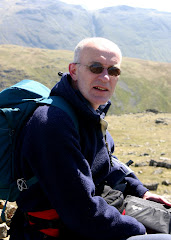 At Kisdon Force our route again meets up with the Pennine Way and proceeds north toward Stonesdale Moor and the remnants of the Tanhill Colliery. Details of the coal mining history would be interesting and whether or not there was still any activity in 1938 (I have records that seem to show abandonment in 1940 and would like confirmation).
At Kisdon Force our route again meets up with the Pennine Way and proceeds north toward Stonesdale Moor and the remnants of the Tanhill Colliery. Details of the coal mining history would be interesting and whether or not there was still any activity in 1938 (I have records that seem to show abandonment in 1940 and would like confirmation).The route also visits the highest inn in England - the Tan Hill Inn is a splendid place and when I visited in 1998 had several framed prints of Pennine way/Wainwright memorabilia. Wainwright relates the family gathering when he visited - does anyone recall the "grizzled companiable old fellow" innkeeper in 1938.
Beyond Tan Hill the route diverges from Wainwright's again as he followed the road easterly before turning north east on what he described as a pony track. The new route leaves Tan Hill and maintains its course along the Pennine Way until meeting again with the original route on the pony track near Sleightholme.

Once the old and new routes join they follow the track past Sleightholme north east with Bowes in the distance with its grand castle.

Following the track it develops into more of a road and remains frustrating as Wainwright had noted in that it bends away from Bowes before turning north at Gilmanby and arriving in the town. Bowes is noted as being the village visited by Dickens during research for Nicholas Nickleby. If I recall rightly the Unicorn Inn figures in the Dickens accounts. I remember Bowes for its main street which is now bypassed and the site of the old petrol station that seemed to have just been left by its owner once the bypass had removed the passing trade.
.
North of Bowes the routes again separate as Wainwright seems to have set off on the road as directly as possible to the next village, Cotherstone.

Wainwright looked at Cotherstone with envious eyes and concluded that it was a village of net-curtain twitchers who kept themselves to themselves. As he approached Teesdale he did not generally like what he found and the dale folk do not hold Wainwright kindly in their thoughts. Any comments from locals would be very useful in this respect as I had one or two less than kind thoughts about him so the scars seem to run deep.

Leaving Cotherstone the old and new routes soon go their separate routes for Wainwright had again followed the road the 2 miles to Romaldkirk. The new route follows the bank of the Tees and passes Woden Croft Farm which had been a school in Dickens' time -any detail would be interesting, especially the history of when it stopped being a harse school.

Romaldkirk is a delightful place which seems little changed since Wainwright visited, with the exception that the Kirk Inn is now more popular than in 1938. Any details of the widowed landlady would be very interesting.

Wainwright looked at Cotherstone with envious eyes and concluded that it was a village of net-curtain twitchers who kept themselves to themselves. As he approached Teesdale he did not generally like what he found and the dale folk do not hold Wainwright kindly in their thoughts. Any comments from locals would be very useful in this respect as I had one or two less than kind thoughts about him so the scars seem to run deep.

Leaving Cotherstone the old and new routes soon go their separate routes for Wainwright had again followed the road the 2 miles to Romaldkirk. The new route follows the bank of the Tees and passes Woden Croft Farm which had been a school in Dickens' time -any detail would be interesting, especially the history of when it stopped being a harse school.

Romaldkirk is a delightful place which seems little changed since Wainwright visited, with the exception that the Kirk Inn is now more popular than in 1938. Any details of the widowed landlady would be very interesting.
Day 3 has seen Tan Hill, evidence of mining both for lead and coal, associations with Dickens and arrived at a dale that received Wainwright's disdain. Comments about these would be useful and as usual anything that is contemporary with Wainwright passing thru.
Under construction


1 comment:
Like your post
Post a Comment